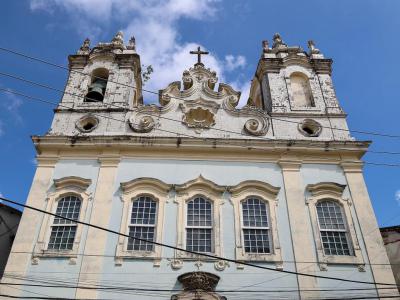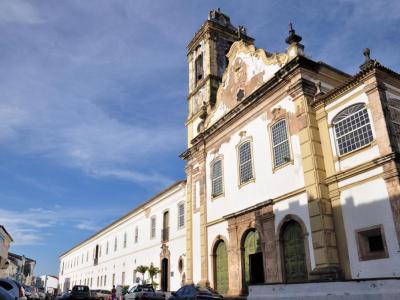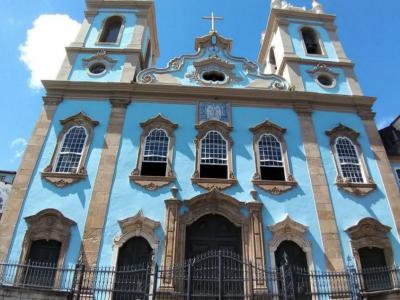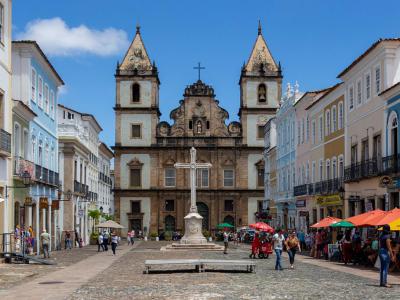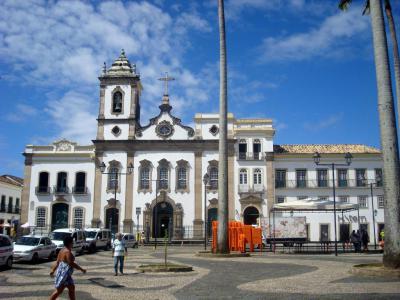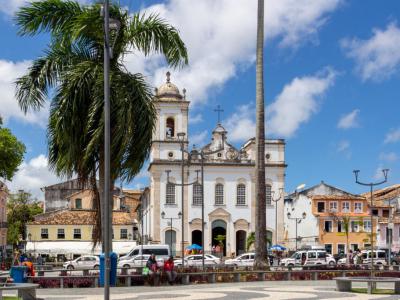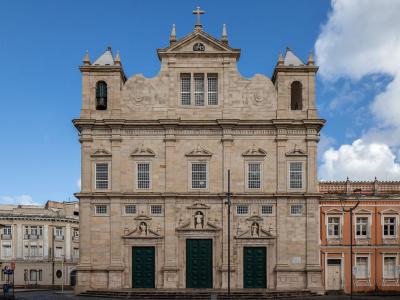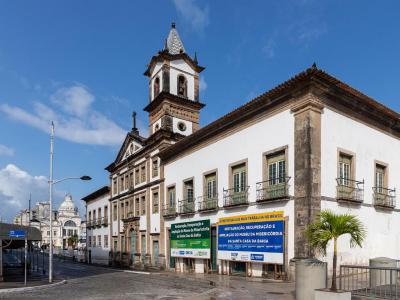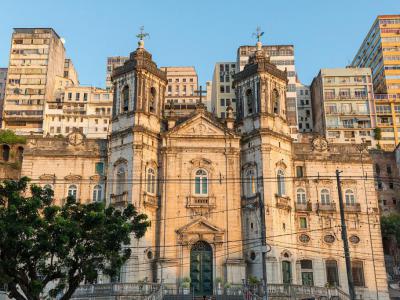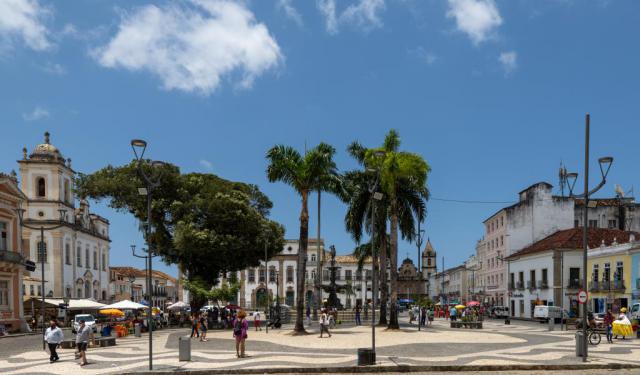Salvador's Historical Churches Tour (Self Guided), Salvador
In Salvador, Brazil, there are quite a few churches emblematic of its cultural and religious heritage. The city's historic district contains so many old Catholic temples that some even joke that you can have a different church to visit there every day of the year. However, if you don't have a whole year to spend in Salvador but still want to make the most of your time in terms of church-seeing, here's our guide.
Let's start at the Church of Boqueirao. This quaint yet significant structure showcases a blend of Rococo and neoclassical styles. Its simple facade belies its historical importance, serving as a testament to the early colonization of Brazil by the Portuguese.
Another notable landmark is the Carmo Convent Church, an imposing edifice that has stood the test of time since its construction in the late 16th century. Currently repurposed as a luxury hotel, it embodies the fusion of history and modernity.
The Church of Our Lady of the Rosary of the Black People, built by enslaved Africans in the 18th century, is a symbol of resistance and resilience. Its vibrant colors and unique blend of African and European influences reflect the cultural diversity of Salvador.
The São Francisco Church and Convent of Salvador is a true masterpiece of Portuguese Baroque architecture, adorned with elaborate gold leaf ornamentation and exquisite tilework. It exemplifies the wealth and opulence of colonial Brazil.
Other notable churches include the Church of the Third Order of Penitence of São Domingos de Osma, the Church of Saint Peter of the Clergymen, the Cathedral Basilica of Salvador, the Church and Museum of Mercy, and the Basilica of the Immaculate Conception.
Exploring these eye-catching sanctuaries is not only a journey through Salvador's past but also an opportunity to appreciate the enduring legacy of its people. So, do follow our self-guided walking tour and discover the city's best churches firsthand.
Let's start at the Church of Boqueirao. This quaint yet significant structure showcases a blend of Rococo and neoclassical styles. Its simple facade belies its historical importance, serving as a testament to the early colonization of Brazil by the Portuguese.
Another notable landmark is the Carmo Convent Church, an imposing edifice that has stood the test of time since its construction in the late 16th century. Currently repurposed as a luxury hotel, it embodies the fusion of history and modernity.
The Church of Our Lady of the Rosary of the Black People, built by enslaved Africans in the 18th century, is a symbol of resistance and resilience. Its vibrant colors and unique blend of African and European influences reflect the cultural diversity of Salvador.
The São Francisco Church and Convent of Salvador is a true masterpiece of Portuguese Baroque architecture, adorned with elaborate gold leaf ornamentation and exquisite tilework. It exemplifies the wealth and opulence of colonial Brazil.
Other notable churches include the Church of the Third Order of Penitence of São Domingos de Osma, the Church of Saint Peter of the Clergymen, the Cathedral Basilica of Salvador, the Church and Museum of Mercy, and the Basilica of the Immaculate Conception.
Exploring these eye-catching sanctuaries is not only a journey through Salvador's past but also an opportunity to appreciate the enduring legacy of its people. So, do follow our self-guided walking tour and discover the city's best churches firsthand.
How it works: Download the app "GPSmyCity: Walks in 1K+ Cities" from Apple App Store or Google Play Store to your mobile phone or tablet. The app turns your mobile device into a personal tour guide and its built-in GPS navigation functions guide you from one tour stop to next. The app works offline, so no data plan is needed when traveling abroad.
Salvador's Historical Churches Tour Map
Guide Name: Salvador's Historical Churches Tour
Guide Location: Brazil » Salvador (See other walking tours in Salvador)
Guide Type: Self-guided Walking Tour (Sightseeing)
# of Attractions: 9
Tour Duration: 1 Hour(s)
Travel Distance: 2.1 Km or 1.3 Miles
Author: vickyc
Sight(s) Featured in This Guide:
Guide Location: Brazil » Salvador (See other walking tours in Salvador)
Guide Type: Self-guided Walking Tour (Sightseeing)
# of Attractions: 9
Tour Duration: 1 Hour(s)
Travel Distance: 2.1 Km or 1.3 Miles
Author: vickyc
Sight(s) Featured in This Guide:
- Igreja do Boqueirao (Church of the Ravine)
- Igreja e Convento de Nossa Senhora do Carmo (Our Lady of Mount Carmel)
- Igreja do Rosário dos Pretos (Church of Our Lady of the Rosary of the Black People)
- Igreja e Convento de Sao Francisco (Church and Convent of St. Francis)
- Igreja de Sao Domingos Gusmao (Church of St. Dominic of Osma)
- Igreja de Sao Pedro dos Clerigos (Church of St. Peter of the Clergymen)
- Catedral Basilica de Salvador (Cathedral Basilica of Salvador)
- Igreja e Museu da Misericórdia (Church and Museum of Mercy)
- Igreja Nossa Senhora da Conceição da Praia (Basilica of the Immaculate Conception)
1) Igreja do Boqueirao (Church of the Ravine)
Back in 1726, amid the remnants of an old defensive trench overlooking the stunning Bay of All Saints (“Baía de Todos-os-Santos”), the Brotherhood of Pardos approached Brazil’s Viceroy, Vasco F. Cesar de Menezes, with an audacious request: “We’d like to build a church here.” The result was this remarkable temple, perched on Santo Antônio Além do Carmo’s slopes, looking for all the world as if it was placed there by divine decree.
Its architecture bears a striking resemblance to the Church of Our Lady of the Rosary of the Black People (“Igreja do Rosário dos Pretos”) over in Pelourinho, but with its own Rococo flair. Construction wrapped up in the mid-1800s, with gleaming white-tiled towers marking its façade. Inside, the décor dances between neoclassical elegance and baroque drama. And the name “Boqueirão”? That’s a nod to the geological fault that conveniently splits Salvador’s Upper and Lower Towns right where the church stands.
Step inside, and you’ll find three altars gilded in gold and rich detail, plus once-hidden paintings revealed during a 2009 restoration. Look up at the ceiling, and you’ll see the Virgin Mary, under the title of the Immaculate Conception, being glorified alongside the Holy Trinity. Add two basements-one transformed into a catacomb-a ground floor, a first floor, and rooms for a sacristy, galleries, a choir, and a consistory, and you’ve got a church that does it all.
When the construction dust finally settled, the Brotherhood of Pardos was upgraded to a Venerable Third Order, a fitting honor for a community that made up the majority of Salvador’s population yet held no political sway. This church was more than a place of worship-it was a symbol of pride and identity for pardos, long before the Rosary of the Black People Church entered the picture.
Today, recognized by IPHAN for its cultural and historical significance, this glorious structure serves as both a sanctuary for religious services and the headquarters of the Brotherhood.
Its architecture bears a striking resemblance to the Church of Our Lady of the Rosary of the Black People (“Igreja do Rosário dos Pretos”) over in Pelourinho, but with its own Rococo flair. Construction wrapped up in the mid-1800s, with gleaming white-tiled towers marking its façade. Inside, the décor dances between neoclassical elegance and baroque drama. And the name “Boqueirão”? That’s a nod to the geological fault that conveniently splits Salvador’s Upper and Lower Towns right where the church stands.
Step inside, and you’ll find three altars gilded in gold and rich detail, plus once-hidden paintings revealed during a 2009 restoration. Look up at the ceiling, and you’ll see the Virgin Mary, under the title of the Immaculate Conception, being glorified alongside the Holy Trinity. Add two basements-one transformed into a catacomb-a ground floor, a first floor, and rooms for a sacristy, galleries, a choir, and a consistory, and you’ve got a church that does it all.
When the construction dust finally settled, the Brotherhood of Pardos was upgraded to a Venerable Third Order, a fitting honor for a community that made up the majority of Salvador’s population yet held no political sway. This church was more than a place of worship-it was a symbol of pride and identity for pardos, long before the Rosary of the Black People Church entered the picture.
Today, recognized by IPHAN for its cultural and historical significance, this glorious structure serves as both a sanctuary for religious services and the headquarters of the Brotherhood.
2) Igreja e Convento de Nossa Senhora do Carmo (Our Lady of Mount Carmel)
Erected in the early 1600s in a prim-and-proper neoclassical style, the Church of Our Lady of Mount Carmel shows off one of the most jaw-dropping sacristies on the planet. Tucked behind it, you’ll find the world’s largest Carmelite convent-complete with two cloisters, 80 cells, and a past life as Brazil’s first fancy-pants historic luxury hotel.
This holy hotspot, founded in 1585 on Rua do Carmo, played host to the Dutch surrender back in the day. Inside, you’ll stumble upon a glorious image of Our Lady sculpted by none other than Chagas, “O Cabra“-one of Brazil’s greatest chisel-wielding geniuses. The altar and tabernacle are dripping in silver, and yes, that’s the very chair King John VI parked himself in during religious services. As if that weren’t enough, the chapel of Our Lady of Piety doubles as the final resting place for poet Junqueira Freire and Dutch-expulsion hero Count Bagnuoli. Talk about VIP seating.
But the real showstopper? That sacristy. It’s a carnival of gilded carvings, ceiling panels spinning tales of Saint Elias, and standout pieces like a 17th-century bronze crucifix and grand statues of Carmelite VIPs-Saint Telesphorus, Saint Dionysius, Saint Peter Thomas, and Saint Andrew Corsini. Oh, and don’t overlook the jacaranda wood cabinets with handcrafted silver handles-pure artistry. And did we mention O Cabra’s masterpiece, “Christ at the Column“? It’s right there, too-a nod to the sculptor’s brilliance.
As for that Dutch surrender story: In 1624, Salvador fell to Dutch troops, and this convent became the nerve center of the Portuguese-Spanish-Brazilian resistance. After a months-long standoff at the Carmo Gates (“Portas do Carmo“), the invaders finally called it quits. And where did they sign the surrender? You guessed it-in what’s now the sacristy. From that day on, the Convent of Mount Carmel stood as a proud symbol of Salvador’s defiance and resilience.
This holy hotspot, founded in 1585 on Rua do Carmo, played host to the Dutch surrender back in the day. Inside, you’ll stumble upon a glorious image of Our Lady sculpted by none other than Chagas, “O Cabra“-one of Brazil’s greatest chisel-wielding geniuses. The altar and tabernacle are dripping in silver, and yes, that’s the very chair King John VI parked himself in during religious services. As if that weren’t enough, the chapel of Our Lady of Piety doubles as the final resting place for poet Junqueira Freire and Dutch-expulsion hero Count Bagnuoli. Talk about VIP seating.
But the real showstopper? That sacristy. It’s a carnival of gilded carvings, ceiling panels spinning tales of Saint Elias, and standout pieces like a 17th-century bronze crucifix and grand statues of Carmelite VIPs-Saint Telesphorus, Saint Dionysius, Saint Peter Thomas, and Saint Andrew Corsini. Oh, and don’t overlook the jacaranda wood cabinets with handcrafted silver handles-pure artistry. And did we mention O Cabra’s masterpiece, “Christ at the Column“? It’s right there, too-a nod to the sculptor’s brilliance.
As for that Dutch surrender story: In 1624, Salvador fell to Dutch troops, and this convent became the nerve center of the Portuguese-Spanish-Brazilian resistance. After a months-long standoff at the Carmo Gates (“Portas do Carmo“), the invaders finally called it quits. And where did they sign the surrender? You guessed it-in what’s now the sacristy. From that day on, the Convent of Mount Carmel stood as a proud symbol of Salvador’s defiance and resilience.
3) Igreja do Rosário dos Pretos (Church of Our Lady of the Rosary of the Black People) (must see)
Perched midway down Pillory Square, the Church of Our Lady of the Rosary of the Black People radiates a striking blue hue, standing as a symbol of black resilience and resistance. Catholic or not, it’s a Salvadorian showstopper you don’t want to miss.
Back in the day, Portugal’s king granted the land to an Afro-Brazilian brotherhood made up of slaves and free blacks. With a vision in mind, they got to work and spent the better part of the 18th century bringing it to life. The facade may be classic Rococo, but those tiled towers with a touch of Indian flair are, in fact, courtesy of Portugal’s colonial ties to Goa, a city on the western coast of India.
Beyond its unique architecture, the church is a living tribute to the African diaspora. Services are laced with Candomblé-inspired rhythms, as the sounds of Afro-Brazilian atabaque drums join the traditional Catholic liturgy. Tuesdays are particularly special-the Mass transforms into a vibrant tapestry of song and dance. Word to the wise: show up early if you want a seat-standing room is all you’ll find once the service kicks off.
And when Saint Barbara and Iansã celebrations roll around? It’s not just a Mass anymore-it’s a full-blown, spirited festival, with this church at its center.
Back in the day, Portugal’s king granted the land to an Afro-Brazilian brotherhood made up of slaves and free blacks. With a vision in mind, they got to work and spent the better part of the 18th century bringing it to life. The facade may be classic Rococo, but those tiled towers with a touch of Indian flair are, in fact, courtesy of Portugal’s colonial ties to Goa, a city on the western coast of India.
Beyond its unique architecture, the church is a living tribute to the African diaspora. Services are laced with Candomblé-inspired rhythms, as the sounds of Afro-Brazilian atabaque drums join the traditional Catholic liturgy. Tuesdays are particularly special-the Mass transforms into a vibrant tapestry of song and dance. Word to the wise: show up early if you want a seat-standing room is all you’ll find once the service kicks off.
And when Saint Barbara and Iansã celebrations roll around? It’s not just a Mass anymore-it’s a full-blown, spirited festival, with this church at its center.
4) Igreja e Convento de Sao Francisco (Church and Convent of St. Francis) (must see)
The Church and Convent of Saint Francis is more than just a historic site-it’s officially one of the Seven Wonders of Portuguese Origin in the World. And it’s easy to see why: the place is overflowing with grandeur and historic charm.
The original church and convent were built by Franciscan friars after their arrival in Salvador in 1587. Sadly, they didn’t withstand the Dutch invasions of the 17th century; however, in the early 1700s, new construction began on the very same site, giving rise to the structures that stand today.
Now a certified national treasure, the interior is home to a jaw-dropping 55,000 hand-painted Portuguese tiles-the largest collection of its kind in any Latin American church. Among the highlights is a striking tiled scene depicting the birth of Saint Francis. Surrounding this masterpiece are intricately carved wood panels dusted with gold, showcasing classic Brazilian Baroque motifs: leaves, pelicans, flowers, and cherubic figures.
Look even closer and you’ll find polychrome statues from Bahia's finest sculptors, as well as intricately carved wood, and even a pair of stone fonts straight from the hands of King João V of Portugal. You’ll also be rewarded with a painted ceiling above, ornate pulpits to the side, and an impressive lineup of saintly figures: Saint Peter of Alcantara, Saint Benedict, Saint Joseph, the Sacred Heart of Jesus, Saint Anthony, and, of course, Saint Francis of Assisi presiding over the high altar. The left aisle brings its own celestial ensemble: Our Lady of the Conception, Our Lady of Glory, Our Lady of Piety, Our Lady of Saint Anne, joined by Saint Lucy and Saint Dominic for good measure.
Out front, a massive stone cross completes the scene. Standing at 26 feet tall and hauled all the way from Lisbon in 1807, it’s the perfect cherry on top of this baroque masterpiece.
The original church and convent were built by Franciscan friars after their arrival in Salvador in 1587. Sadly, they didn’t withstand the Dutch invasions of the 17th century; however, in the early 1700s, new construction began on the very same site, giving rise to the structures that stand today.
Now a certified national treasure, the interior is home to a jaw-dropping 55,000 hand-painted Portuguese tiles-the largest collection of its kind in any Latin American church. Among the highlights is a striking tiled scene depicting the birth of Saint Francis. Surrounding this masterpiece are intricately carved wood panels dusted with gold, showcasing classic Brazilian Baroque motifs: leaves, pelicans, flowers, and cherubic figures.
Look even closer and you’ll find polychrome statues from Bahia's finest sculptors, as well as intricately carved wood, and even a pair of stone fonts straight from the hands of King João V of Portugal. You’ll also be rewarded with a painted ceiling above, ornate pulpits to the side, and an impressive lineup of saintly figures: Saint Peter of Alcantara, Saint Benedict, Saint Joseph, the Sacred Heart of Jesus, Saint Anthony, and, of course, Saint Francis of Assisi presiding over the high altar. The left aisle brings its own celestial ensemble: Our Lady of the Conception, Our Lady of Glory, Our Lady of Piety, Our Lady of Saint Anne, joined by Saint Lucy and Saint Dominic for good measure.
Out front, a massive stone cross completes the scene. Standing at 26 feet tall and hauled all the way from Lisbon in 1807, it’s the perfect cherry on top of this baroque masterpiece.
5) Igreja de Sao Domingos Gusmao (Church of St. Dominic of Osma)
Perched on Terreiro de Jesus, flanked by the Cathedral Basilica of Salvador and Bahia’s Faculty of Medicine, stands a church that stops passersby in their tracks-not because it’s towering, but because it’s got just one tower. This lopsided beauty is the Church of Saint Dominic of Osma, or simply São Domingos to its friends.
Built in 1731, São Domingos sports a Rococo façade while the interior leans Neoclassical. But the pièce de résistance is undoubtedly the nave’s ceiling. Stretching a whopping 173 square meters, it’s adorned with a Baroque illusionist masterpiece attributed to José Joaquim da Rocha-Brazil’s Baroque VIP. The painting offers a dazzling view of paradise, using the concave ceiling to trick your eyes into seeing infinite heavenly depth.
Once you’ve marveled at the ceiling and soaked in the ornate décor, you can step into the sacristy and the Chapel of the Good Death. Back in the day, this chapel hosted numerous wakes thanks to its proximity to Pelourinho’s Institute of Legal Medicine. Now it moonlights as a museum featuring Dominican Order saints like Saint Martin de Porres, Saint Thomas Aquinas, Saint Catherine of Siena, Saint Paula, and Saint Cecilia.
Feeling adventurous? Descend into the catacombs to mingle with some 18th-century tombs. Or, if you’re up for a climb, tackle the 75 steps to the top of the lone tower. This cube-shaped lookout features four windows, each hosting its own bell. The largest bell, weighing in at 1.2 tons, was installed in 1789. Unfortunately, it’s never been restored, so it’s strictly a “look, don’t listen” situation.
Built in 1731, São Domingos sports a Rococo façade while the interior leans Neoclassical. But the pièce de résistance is undoubtedly the nave’s ceiling. Stretching a whopping 173 square meters, it’s adorned with a Baroque illusionist masterpiece attributed to José Joaquim da Rocha-Brazil’s Baroque VIP. The painting offers a dazzling view of paradise, using the concave ceiling to trick your eyes into seeing infinite heavenly depth.
Once you’ve marveled at the ceiling and soaked in the ornate décor, you can step into the sacristy and the Chapel of the Good Death. Back in the day, this chapel hosted numerous wakes thanks to its proximity to Pelourinho’s Institute of Legal Medicine. Now it moonlights as a museum featuring Dominican Order saints like Saint Martin de Porres, Saint Thomas Aquinas, Saint Catherine of Siena, Saint Paula, and Saint Cecilia.
Feeling adventurous? Descend into the catacombs to mingle with some 18th-century tombs. Or, if you’re up for a climb, tackle the 75 steps to the top of the lone tower. This cube-shaped lookout features four windows, each hosting its own bell. The largest bell, weighing in at 1.2 tons, was installed in 1789. Unfortunately, it’s never been restored, so it’s strictly a “look, don’t listen” situation.
6) Igreja de Sao Pedro dos Clerigos (Church of St. Peter of the Clergymen)
The Brotherhood of Saint Peter of the Clergymen got its start back in the 15th century on the Iberian Peninsula. Known as the “secular priests in Saint Peter’s habit,” their main purpose was (and still is) looking after aging, ailing, or retired priests who don’t belong to a religious order. Naturally, they picked Saint Peter-the lead apostle in Christ’s crew-as their patron saint.
Fast-forward a bit, and the Brotherhood made its way to Brazil in the 16th century, settling down in Salvador during the time of Dom Antônio Barreiros, the third bishop of Brazil. Their base was Largo Terreiro de Jesus in Pelourinho, where they constructed a church that’s a love letter to the artistic styles of the era. Built around 1709 and given a few touch-ups in the 18th and 19th centuries, it became a certified historic treasure in 1938, courtesy of IPHAN, and now enjoys UNESCO World Heritage status as part of Salvador’s Historic Center.
Inside, the décor is a charming clash of Rococo exuberance and Neoclassical elegance. The main altar, inspired by prints from Italian Jesuit artist Andrea Pozzo (a big name in 18th- and 19th-century Brazil), takes center stage. Supporting the scene are two corner altars flanking the chancel arch. At the heart of it all stands a stunning image of Our Lady of the Immaculate Conception, flanked on either side by grand statues of Saint Peter and Saint Paul. In short, it’s a visual feast that Saint Peter himself would be proud of.
Fast-forward a bit, and the Brotherhood made its way to Brazil in the 16th century, settling down in Salvador during the time of Dom Antônio Barreiros, the third bishop of Brazil. Their base was Largo Terreiro de Jesus in Pelourinho, where they constructed a church that’s a love letter to the artistic styles of the era. Built around 1709 and given a few touch-ups in the 18th and 19th centuries, it became a certified historic treasure in 1938, courtesy of IPHAN, and now enjoys UNESCO World Heritage status as part of Salvador’s Historic Center.
Inside, the décor is a charming clash of Rococo exuberance and Neoclassical elegance. The main altar, inspired by prints from Italian Jesuit artist Andrea Pozzo (a big name in 18th- and 19th-century Brazil), takes center stage. Supporting the scene are two corner altars flanking the chancel arch. At the heart of it all stands a stunning image of Our Lady of the Immaculate Conception, flanked on either side by grand statues of Saint Peter and Saint Paul. In short, it’s a visual feast that Saint Peter himself would be proud of.
7) Catedral Basilica de Salvador (Cathedral Basilica of Salvador) (must see)
The 17th-century Cathedral Basilica, also known as the “Sé,” is the undisputed matriarch of Brazilian Catholic churches. A heady mix of Baroque, Rococo, and Neoclassical flair, this architectural diva was originally built as part of a Jesuit monastic and educational complex. Built from sandstone blocks shipped all the way from Portugal, its history took a dramatic turn in the 1620s when the Dutch captured it, turned it into a warehouse, and made off with its silver finery. After the Portuguese regained control, the church was rebuilt in a Mannerist style to mimic the Jesuit Church of Coimbra back in Portugal. Even a devastating fire in the early 1900s could not hold it down; by 1933, it was restored once more, proving it’s as indestructible as it is elegant.
Step inside and you’re treated to a feast of colonial opulence: 16th-century tiles in the sacristy shipped from Macau, intricate ivory and tortoiseshell inlays from Goa on the third altar on the right, and enough gold leaf to dazzle the eye at every turn. Indeed, the church’s 13 gold-plated altars are a stunning display, covered in over 50,000 gold leaves, 5,000 silver leaves, and shaped by countless hours of skilled craftsmanship.
If that’s not enough, you’ll be treated to a gallery of 17th-century paintings, 30 carefully restored reliquary busts, and two exquisite altars that rank among the finest examples of late 16th-century Brazilian sacred art. The nave, crowned with the Latin inscription “IHS” (Jesus Humanity Savior), was painstakingly assembled over two years by five master carpenters using four shiploads of noble woods. Clearly, no expense-or effort-was spared.
As the glittering centerpiece of Salvador’s UNESCO-listed Historic Center, this cathedral rolls out the red carpet for history buffs and art lovers.
Step inside and you’re treated to a feast of colonial opulence: 16th-century tiles in the sacristy shipped from Macau, intricate ivory and tortoiseshell inlays from Goa on the third altar on the right, and enough gold leaf to dazzle the eye at every turn. Indeed, the church’s 13 gold-plated altars are a stunning display, covered in over 50,000 gold leaves, 5,000 silver leaves, and shaped by countless hours of skilled craftsmanship.
If that’s not enough, you’ll be treated to a gallery of 17th-century paintings, 30 carefully restored reliquary busts, and two exquisite altars that rank among the finest examples of late 16th-century Brazilian sacred art. The nave, crowned with the Latin inscription “IHS” (Jesus Humanity Savior), was painstakingly assembled over two years by five master carpenters using four shiploads of noble woods. Clearly, no expense-or effort-was spared.
As the glittering centerpiece of Salvador’s UNESCO-listed Historic Center, this cathedral rolls out the red carpet for history buffs and art lovers.
8) Igreja e Museu da Misericórdia (Church and Museum of Mercy)
This stately 17th-century mansion, perched between two squares, doesn’t just house history-it practically whispers it through its walls. Step into the Museum of Mercy, where every corridor and grand hall doubles as a time machine. Once the site of Bahia’s very first hospital (dating back to 1549, no less), it’s seen everything from royal visits to high-stakes medical miracles.
The museum isn’t just any old cultural hotspot; with a jaw-dropping collection of over 3,000 items, it’s like scrolling through 500 years of Bahia’s backstory-but, you know, without the scrolling. Highlights? A chair specially made for Emperor Dom Pedro II’s 1859 visit, Ruy Barbosa’s historic desk, Portuguese tile panels depicting eerie processions, the Pharmacy Hall, and the pièce de résistance: the oldest gasoline-powered car on display in all of Brazil.
Meanwhile, the Church of Mercy, conveniently connected to the museum, offers a mash-up of Baroque, Rococo, and Neoclassical styles, serving as both a spiritual haven and a backdrop for everything from weddings to concerts. It also features the “Concert in the Churches” series, with performances by groups and conductors.
So, whether you’re here for the ancient furniture, the tile panels, or just to attend a concert, this site delivers on every level.
The museum isn’t just any old cultural hotspot; with a jaw-dropping collection of over 3,000 items, it’s like scrolling through 500 years of Bahia’s backstory-but, you know, without the scrolling. Highlights? A chair specially made for Emperor Dom Pedro II’s 1859 visit, Ruy Barbosa’s historic desk, Portuguese tile panels depicting eerie processions, the Pharmacy Hall, and the pièce de résistance: the oldest gasoline-powered car on display in all of Brazil.
Meanwhile, the Church of Mercy, conveniently connected to the museum, offers a mash-up of Baroque, Rococo, and Neoclassical styles, serving as both a spiritual haven and a backdrop for everything from weddings to concerts. It also features the “Concert in the Churches” series, with performances by groups and conductors.
So, whether you’re here for the ancient furniture, the tile panels, or just to attend a concert, this site delivers on every level.
9) Igreja Nossa Senhora da Conceição da Praia (Basilica of the Immaculate Conception)
At the foot of the mountain connecting the Upper and Lower Cities, you'll find the Basilica of Our Lady of the Conception of the Beach-yes, the third one built on this spot. Its name comes from the locals, who figured it was pretty close to the beach. Built in 1623, it’s one of the oldest parishes in the Archdiocese of São Salvador da Bahia.
A little history lesson: In 1549, Portuguese ships arrived in Salvador, and guess who they brought? An image of the Patroness of Lisbon, which went on a world tour with the troops. This unique image was placed in the first church, whose ruins are still standing today. It reigned supreme until 1946, when Our Lady of the Immaculate Conception was crowned the Patroness of Bahia. The church itself, built in the Baroque style, was crafted entirely from lioz stone brought from Portugal. It took 300 years to complete-three generations of artisans, whale oil, and a whole lot of stonework. Fun fact: it's the only modular church in Salvador.
Inside, the floor is a jaw-dropper-crafted from lioz stone and Carrara marble, it’s one of the site's main attractions. Step into the “primitive church,“ where it all started, left in ruins with candles flickering all around. Oh, and there’s a window that lets you peek at the historic staircase that once connected the Lower City to the Upper City.
Next door, the brand-new Conception of the Beach (“Conceição da Praia“) Ceremonial has a modern twist, blending sleek design with the church's original stone walls. It can hold 1,000 guests-perfect for a big wedding, or you know, a major celebration.
A little history lesson: In 1549, Portuguese ships arrived in Salvador, and guess who they brought? An image of the Patroness of Lisbon, which went on a world tour with the troops. This unique image was placed in the first church, whose ruins are still standing today. It reigned supreme until 1946, when Our Lady of the Immaculate Conception was crowned the Patroness of Bahia. The church itself, built in the Baroque style, was crafted entirely from lioz stone brought from Portugal. It took 300 years to complete-three generations of artisans, whale oil, and a whole lot of stonework. Fun fact: it's the only modular church in Salvador.
Inside, the floor is a jaw-dropper-crafted from lioz stone and Carrara marble, it’s one of the site's main attractions. Step into the “primitive church,“ where it all started, left in ruins with candles flickering all around. Oh, and there’s a window that lets you peek at the historic staircase that once connected the Lower City to the Upper City.
Next door, the brand-new Conception of the Beach (“Conceição da Praia“) Ceremonial has a modern twist, blending sleek design with the church's original stone walls. It can hold 1,000 guests-perfect for a big wedding, or you know, a major celebration.
Walking Tours in Salvador, Brazil
Create Your Own Walk in Salvador
Creating your own self-guided walk in Salvador is easy and fun. Choose the city attractions that you want to see and a walk route map will be created just for you. You can even set your hotel as the start point of the walk.
Salvador Introduction Walking Tour
Salvador is a coastal city in Brazil. Founded in 1548, it is the country's former capital and serves as the current capital of the state of Bahia. It is one of the oldest planned cities in the Americas.
Due to its location, early Europeans turned Salvador into an important trade route for slavery. Of the nearly 5 million enslaved people who were imported to Brazil, about 1.3 million were... view more
Tour Duration: 1 Hour(s)
Travel Distance: 1.6 Km or 1 Miles
Due to its location, early Europeans turned Salvador into an important trade route for slavery. Of the nearly 5 million enslaved people who were imported to Brazil, about 1.3 million were... view more
Tour Duration: 1 Hour(s)
Travel Distance: 1.6 Km or 1 Miles
The Most Popular Cities
/ view all



